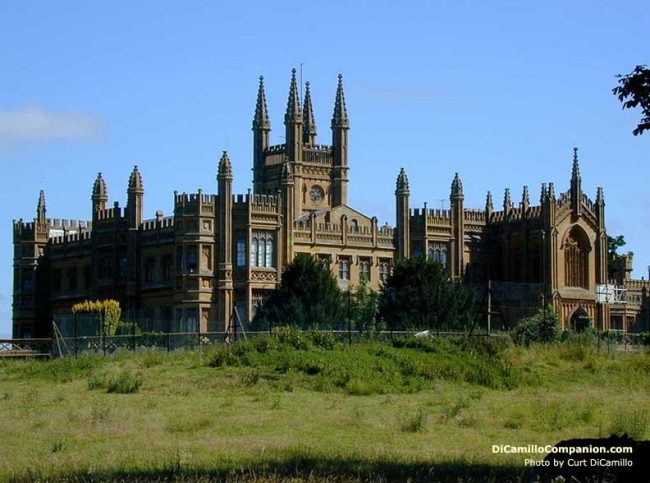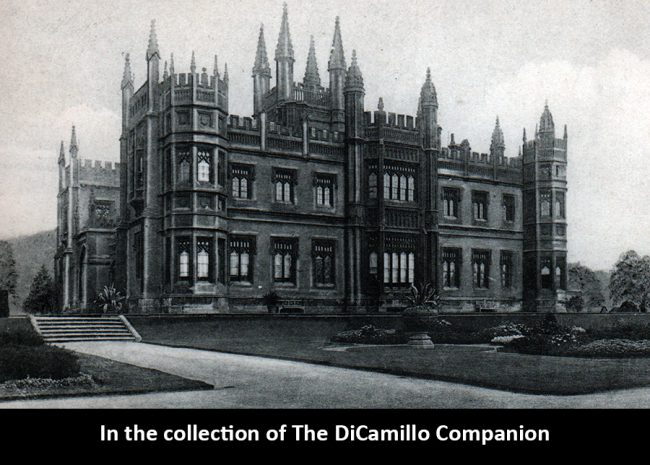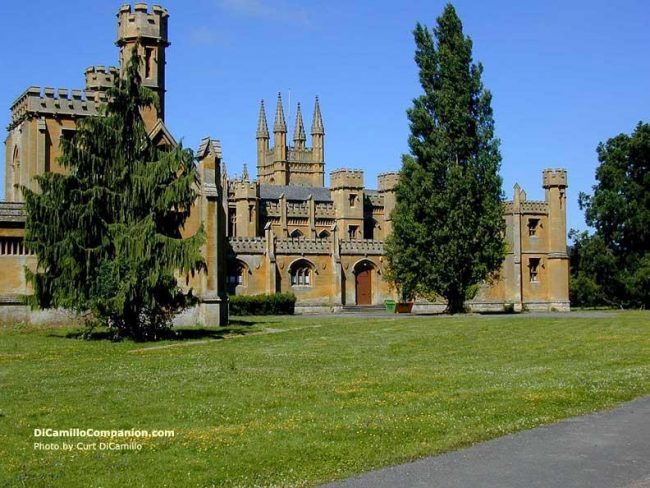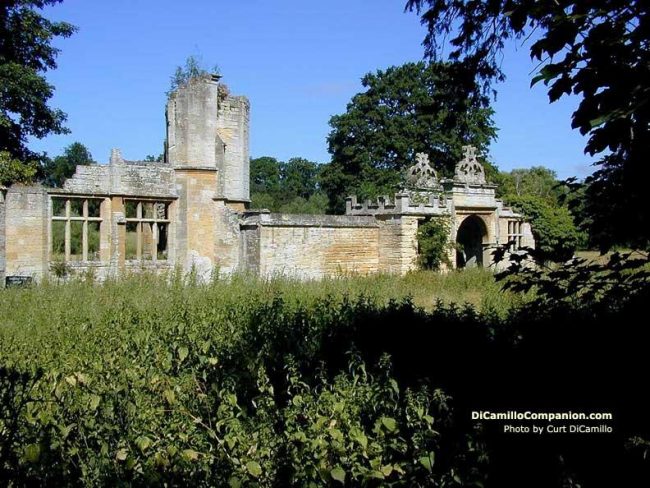

The House from a circa 1909 postcard


Oriel Window

Remains of the Tudor Gatehouse
Earlier Houses: Toddington House, or Toddington Manor House, was an early 17th century Jacobean mansion, last occupied by Charles Hanbury-Tracy after his marriage in 1798 to his cousin. The house was partly destroyed by fire in 1800 and subsequently renovated, but was then attacked by dry rot. It was pulled down by Hanbury-Tracy once he moved into Toddington Manor (built nearby on higher ground to avoid the damp). The ruinous Grade II*-listed central section of the gatehouse is all that remains today from the earlier house.
Built / Designed For: Charles Hanbury-Tracy, 1st Lord Sudeley
House & Family History: Built 1819-35 by and for Charles Hanbury-Tracy, 1st Lord Sudeley (1778-1858), who chaired the commission in 1836 that chose the design by Sir Charles Barry for rebuilding the Houses of Parliament (supposedly based on Toddington), the house was originally attributed to Barry, but the view today is that Hanbury-Tracy was probably his own architect. Toddington cost £150,000 to build (equivalent to approximately £116 million in 2016 inflation-adjusted values using the labor value commodity index). In 1798 Charles Hanbury married his cousin, Henrietta Tracy, only child and heiress of the 8th (and last) Viscount Tracy of Rathcoole, owner of the Toddington Estate, whereupon he changed his name to Hanbury-Tracy. The Hanbury-Tracy family sold the house in 1901, after going bankrupt in 1894. During World War II Toddington housed soldiers. Between 1948 and 1972 the house was owned by the Order/Congregation of Christian Brothers, who used it for administrative offices and as a noviciate. In 1972 the car auction entrepreneur David Wickens purchased the manor for approximately £3 million; he ran car auctions here until 1976. The Avicenna Foundation (owner 1976-89) operated the house as a £5,000-a-year school for students from the Middle East and Africa in the 1980s (until 1985). Between 1989 and 2005 Toddington was owned by an offshore investment company, Toddington Investments Ltd. (believed to be a Middle Eastern syndicate), which allowed it to fall into disrepair. The Toddington Estate, which included the house, the service wing, three cottages, 124 acres, and the stables/coach house (which is surrounded by a indoor vaulted horse riding track), was listed for sale in September of 2000 for £3.2 million. A planned purchase and £30 million redevelopment of Toddington into a luxury hotel (including a 200-bedroom modern extension and parking for 300 cars) by Warner Hotels was called off in August 2004 after opposition by local residents and conservationists. The 300-room Gothic Revival house was purchased by 40-year-old British contemporary artist Damien Hirst in August of 2005 for £3 million. Hirst intends to work, in cooperation with Historic England, to restore the house to its former glory as a family home and museum to house his extensive collection of his own, and other artists,' work. The estimated cost of the restoration is £10 million. In June 2006 Hirst announced that the house was covered in scaffolding and had been treated for dry rot, and was to be left for two years, when the old roof was planned to be removed. The interior will need a lot of work, which could take five-to-ten years, after which it will be opened to the public as a museum housing his art collection (currently 200 to 300 pieces). Hirst received £11,132,180 from Sotheby's London auction of his closed Pharmacy restaurant's contents (Notting Hill Gate, London) on October 18, 2004. He came to prominence in 1995, when he won the Turner Prize for works, including his 1993 "Mother and Child Divided," a half-sliced cow and calf in two formaldehyde-filled tanks. In 2018, with the house still covered in scaffolding, Historic England put Toddington Manor on its Heritage at Risk Register. (We are grateful to Andrew Triggs and to Adam Stanford [www.adam-stanford.co.uk] for contributing substantial information to this history of Toddington).
Collections: A set of tapestries of the four seasons made for old Toddington House in 1611 by Ralph Sheldon of Warwickshire was purchased by the 2nd Marquess of Salisbury and is today in the collection of Hatfield House, where they are considered the finest English tapestries of their period. Heraldic stained glass from Lord Sudeley's collection was sold at auction in Munich on October 4, 1911. A collection of approximately 580 architectural drawings and related images for the construction of Toddington Manor, 1820-49 and 1862-76 (the property of Lord Sudeley, a descendant of the builder of Toddington), was auctioned at Christie's on November 16, 2005; the drawings sold for £33,600 to Damien Hirst, who purchased Toddington Manor itself in August of 2005.
Chapel & Church: St. Andrew's Church (previously called St. Leonard's) is on the grounds of the estate.
Architect: Charles Barry Sr.
Date: 1819-35Architect: Charles Hanbury-Tracy (Sudeley)
Date: 1819-35John Bernard (J.B.) Burke, published under the title of A Visitation of the Seats and Arms of the Noblemen and Gentlemen of Great Britain and Ireland, among other titles: Vol. II, p. 205, 1853. (Plate 2.S. Vol. II, p. 1).
Country Life: XV, 630, 1904. LXXXII, 374, 1937.
House Listed: Grade I
Park Listed: Grade II
Current Seat / Home of: Damien Hirst; here since 2005.
Past Seat / Home of: SEATED AT EARLIER HOUSE: Henry Leigh Tracy, 8th Viscount Tracy, 18th century. SEATED AT CURRENT HOUSE: Charles Hanbury-Tracy, 1st Lord Sudeley, 19th century. David Wickens, 1972-76.
Current Ownership Type: Individual / Family Trust
Primary Current Ownership Use: Private Home
Ownership Details: Hirst intends to restore the House and use it as a private home and museum.
House Open to Public: No
Historic Houses Member: No